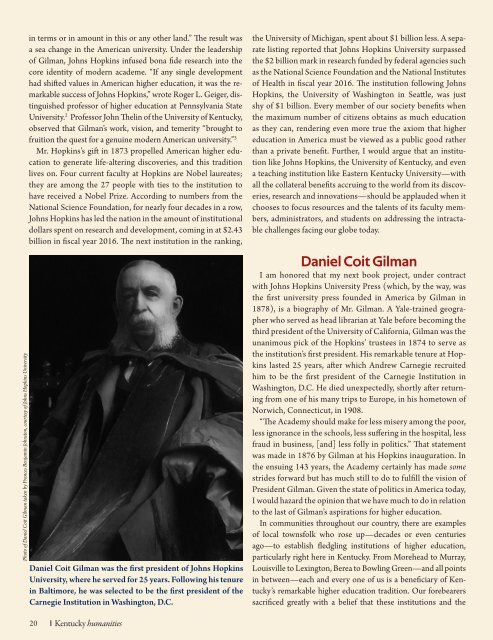Kentucky Humanities — Fall 2019
Timely, thoughtful and entertaining — a unique magazine about Kentucky’s people, culture and history. We are Telling Kentucky’s Story in each issue of Kentucky Humanities, a program of Kentucky Humanities.
Timely, thoughtful and entertaining — a unique magazine about Kentucky’s people, culture and history. We are Telling Kentucky’s Story in each issue of Kentucky Humanities, a program of Kentucky Humanities.
- TAGS
- humanities
- kentucky
Create successful ePaper yourself
Turn your PDF publications into a flip-book with our unique Google optimized e-Paper software.
Photo of Daniel Coit Gilman taken by Frances Benjamin Johnston, courtesy of Johns Hopkins University<br />
in terms or in amount in this or any other land.” The result was<br />
a sea change in the American university. Under the leadership<br />
of Gilman, Johns Hopkins infused bona fide research into the<br />
core identity of modern academe. “If any single development<br />
had shifted values in American higher education, it was the remarkable<br />
success of Johns Hopkins,” wrote Roger L. Geiger, distinguished<br />
professor of higher education at Pennsylvania State<br />
University. 2 Professor John Thelin of the University of <strong>Kentucky</strong>,<br />
observed that Gilman’s work, vision, and temerity “brought to<br />
fruition the quest for a genuine modern American university.” 3<br />
Mr. Hopkins’s gift in 1873 propelled American higher education<br />
to generate life-altering discoveries, and this tradition<br />
lives on. Four current faculty at Hopkins are Nobel laureates;<br />
they are among the 27 people with ties to the institution to<br />
have received a Nobel Prize. According to numbers from the<br />
National Science Foundation, for nearly four decades in a row,<br />
Johns Hopkins has led the nation in the amount of institutional<br />
dollars spent on research and development, coming in at $2.43<br />
billion in fiscal year 2016. The next institution in the ranking,<br />
Daniel Coit Gilman was the first president of Johns Hopkins<br />
University, where he served for 25 years. Following his tenure<br />
in Baltimore, he was selected to be the first president of the<br />
Carnegie Institution in Washington, D.C.<br />
the University of Michigan, spent about $1 billion less. A separate<br />
listing reported that Johns Hopkins University surpassed<br />
the $2 billion mark in research funded by federal agencies such<br />
as the National Science Foundation and the National Institutes<br />
of Health in fiscal year 2016. The institution following Johns<br />
Hopkins, the University of Washington in Seattle, was just<br />
shy of $1 billion. Every member of our society benefits when<br />
the maximum number of citizens obtains as much education<br />
as they can, rendering even more true the axiom that higher<br />
education in America must be viewed as a public good rather<br />
than a private benefit. Further, I would argue that an institution<br />
like Johns Hopkins, the University of <strong>Kentucky</strong>, and even<br />
a teaching institution like Eastern <strong>Kentucky</strong> University<strong>—</strong>with<br />
all the collateral benefits accruing to the world from its discoveries,<br />
research and innovations<strong>—</strong>should be applauded when it<br />
chooses to focus resources and the talents of its faculty members,<br />
administrators, and students on addressing the intractable<br />
challenges facing our globe today.<br />
Daniel Coit Gilman<br />
I am honored that my next book project, under contract<br />
with Johns Hopkins University Press (which, by the way, was<br />
the first university press founded in America by Gilman in<br />
1878), is a biography of Mr. Gilman. A Yale-trained geographer<br />
who served as head librarian at Yale before becoming the<br />
third president of the University of California, Gilman was the<br />
unanimous pick of the Hopkins’ trustees in 1874 to serve as<br />
the institution’s first president. His remarkable tenure at Hopkins<br />
lasted 25 years, after which Andrew Carnegie recruited<br />
him to be the first president of the Carnegie Institution in<br />
Washington, D.C. He died unexpectedly, shortly after returning<br />
from one of his many trips to Europe, in his hometown of<br />
Norwich, Connecticut, in 1908.<br />
“The Academy should make for less misery among the poor,<br />
less ignorance in the schools, less suffering in the hospital, less<br />
fraud in business, [and] less folly in politics.” That statement<br />
was made in 1876 by Gilman at his Hopkins inauguration. In<br />
the ensuing 143 years, the Academy certainly has made some<br />
strides forward but has much still to do to fulfill the vision of<br />
President Gilman. Given the state of politics in America today,<br />
I would hazard the opinion that we have much to do in relation<br />
to the last of Gilman’s aspirations for higher education.<br />
In communities throughout our country, there are examples<br />
of local townsfolk who rose up<strong>—</strong>decades or even centuries<br />
ago<strong>—</strong>to establish fledgling institutions of higher education,<br />
particularly right here in <strong>Kentucky</strong>. From Morehead to Murray,<br />
Louisville to Lexington, Berea to Bowling Green<strong>—</strong>and all points<br />
in between<strong>—</strong>each and every one of us is a beneficiary of <strong>Kentucky</strong>’s<br />
remarkable higher education tradition. Our forebearers<br />
sacrificed greatly with a belief that these institutions and the<br />
20 <strong>Kentucky</strong> humanities




